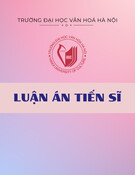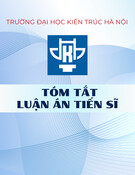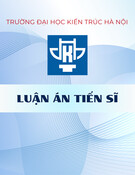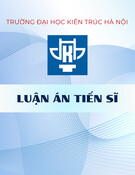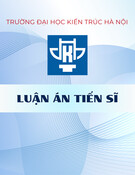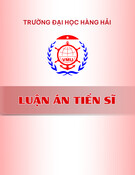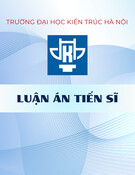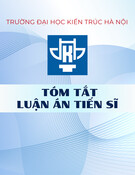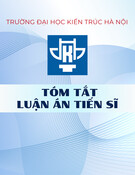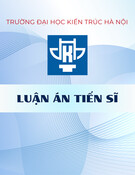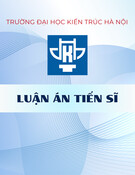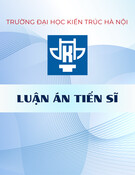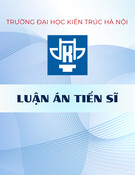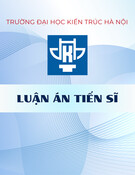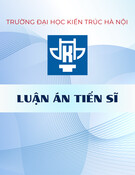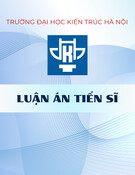MINISTRY OF EDUCATION AND TRAINING HANOI NATIONAL UNIVERSITY OF EDUCATION
NGUYEN THI BICH HOP
CONCEPTUAL METAPHORS DOMAIN "FOOD"
IN VIETNAMESE
Speciality: Vietnamese Linguistic
Classification: 62.22.01.02
PH.D. THESIS SUMMMARIZATION
The thesis is carried out at: Hanoi National University of Education
Advisor: Associate Professor Doctor. Dang Thi Hao Tam
Examiner 1: Professor Doctor. Bui Minh Toan
Hanoi National University of Education
Examiner 2: Associate Professor Doctor. Nguyen Van Loc
Thai Nguyen University of Education
Examiner 3: Associate Professor Doctor. Pham Van Hao
Vietnam Linguistic Association
The thesis will be defended in front of the
……………
Board of Examiners for a Phylosophy Degree at
Hanoi national university of education
At: …….. on ………………..
The thesis is available at library:
National Library of Vietnam
Library of Hanoi National University of Education
THE RESEARCH MADE BY THE AUTHOR
1. Nguyen Thi Bich Hop (2013), "Elementary field vocabulary
Vietnamese indicative of human feelings with food and human notions
(in Vietnamese and English)", Journal of Dictionary and encyclopedia
no. 3 (23) 2013.
2. Nguyen Thi Bich Hop (2013), "Conceptual metaphor "items relating to
food" in Vietnamese" (Proceedings National Workshop of Linguistics,
University of Education 10/2013)
3. Nguyen Thi Bich Hop (2015), "Entity metaphor with target domain
concept "food" in Vietnamese standpoint Cognitive Linguistics"
(National Workshop of Linguistics, University of Saigon 04/2015)
4. Nguyen Thi Bich Hop (2015), "Oriented metaphor of concept "food" in
Vietnamese", Journal of Language No. 6 (313)2015.
PROLOGUE
1.1. "People first need to eat, drink, have shelter and clothes before doing politics, science, art, and religion". That is the statement of Engels in his Feunaral oration reading in front of the Karl Marx grave. In which, "eating" is listed the first essential demand of human. Moreover, food is also paid attention to the areas of the cultural and spiritual. Do Huu Chau in [7] stated that different cultures lead to the different languages; different languages leads to the differences in cultural behaviors, and metaphor is one part of the culture. Thus, the consistent viewpoint has been confirmed for a long time is that culinary as well as language (more specific, the metaphor) has a close relationship with culture.
According to the concept of world cognitive linguistics, "food" is one of the basic fundamental source. (Kovecses identified in "Cooking and Food" in [141]. Research metaphorical notion of "food" in Vietnamese in comparision with another language will help find the similarities and differences in culture and thinking.
1.2. Language reflects reality through the subjective prism. According to the viewpoint of cognitive science: language is a tool of human cognitive, in which, the metaphor is one of the typical and effective tools. Cognitive linguistics focus on the relationship between language – psychological and is the research object of the interdisciplinary science. Metaphor does not only appear in poetry but also plays an important role in many areas such as daily life, economic, diplomatic, advertisement, science, cinema and politics, etc..
In Vietnam, cognitive linguistics is a quite young and new research. However, it has gained many achievements. It can be said that, cognitive linguistics in general, and the conceptual metaphors in particular are getting the attention of the Vietnamese linguists, and is a potential and promising direction.
1.3. However, in Vietnam, among researches on cognitive linguistics, there has not been any individual work studying about Food in Vietnamese language. From the above reasons, we decided to choose the theme: Conceptual metaphors domain " food" in Vietnamese. 2. Purpose and research tasks 2.1. Research purposes
The aim of the thesis is to apply the theory in cognitive linguistics to Vietnamese to establish the conceptual structure and conceptual domain “food”, discover the target domains, the source domains, mapping system and the mapping mechanism among the conceptual domains; codifying metaphorical notion of "food" in Vietnamese in order to study cognitive characteristics and Vietnamese cultural identity through conceptual metaphor of "food”.
In addition, the thesis also noted the metonymy cognitive phenomenon, and
blending concepts in the relation of the conceptual metaphors. 2.2. Research Tasks
Systematizing the cognitive linguistics issues to use it as the basic theoretical for the subject directly; selecting some solutions to the unrealized unify theoretical issues.
Finding out the conception and conceptual domain of "food" in Vietnamese; building the domain structures by identifying and analyzing the typical data and sociological surveys.
Investigating and researching the other conteptual domains which have metaphor relation to the conceptual domain of "food"; setting the mapping system; identifying mapping mechanisms between the domains and noting the fusion concept.
Counting, classifying and analyzing the highlight concept of "food". Distilling and explaining the value of cultural and ethnic identity of
thinking through the metaphorical conceptual of "food".
Comparing and contrasting to the foreign languages in the case of
necessity. 3. The Objects and scopes of research 3.1. Research objects:
The objects of the research are all topics of cognitive function, structure, characteristics, mechanism action and the issues related to conceptual metaphor systems domain "food" in Vietnamese. 3.2. The scope of Research
The scope of research is the whole system of conceptual metaphorical of "food" in Vietnamese from traditional to modern time in the general relationship between the source domain, target domain, mapping systems and the involved mindset cultural valuable.
The thesis is mainly focus on doing survey to explore the conceptual metaphor of "food” in the natural language, folk songs, proverbs, idioms a place to store the living conception and cultural knowledge of the Vietnamese; language in the literature works of Vietnam modern; in the cinema, contemporary journalism in oder to identify the conceptual metaphors in traditional as well as living contemporary of Vietnamese.
The English used for comparison in the thesis were extracted from the the website search on a tool text
Corpus, British National http://www.natcorp.ox.ac.uk/. 4. Research Methodology
Methods of analysis, describing Prime statistical methods, classification Methods of sociological investigation Comparative method 5. New contribution of the thesis 5.1. Theory
The research’s results will contribute to the theory of cognitive linguistics in
Vietnam.
The thesis also contributes to the demonstration that cognitive metaphor is not only the Rhetorical figure of poetry but also an aspect of daily language, culture and thinking. 5.2. Reality
The thesis is a work applying the theory of cognitive linguistics to the Vietnamese practical to analyze and evaluate the literature linguistic data and living language. The thesis puts the conception and the conceptual metaphorical of "food" in the relations with Vietnam culture, using culture to explain the estimative cognitive and use conceptual metaphors to identify cultural factors.
The results of the research can be used as an example of Vietnamese culture to spread, introduce or apply in the teaching and studying about the metaphors and culture of Vietnamese or teaching Vietnamese.
In conclusion, the thesis is the first PhD work in Vietnam deeply study about the conceptual metaphor domain "food" in the view of the cognitive linguistic. 6. The structure of the thesis
Apart from the prologue, conclusion, references and appendices, the
dissertation consists of 4 chapters:
Chapter 1: Overview of research and basis theoretical Chapter 2: Conceptual Domain of "food" in Vietnamese Chapter 3: Mapping metaphors, conceptual blending of "food" with the
other domain concepts in Vietnamese.
Chapter 4: The conceptual metaphor system of "food" in Vietnamese.
Chapter 1 OVERVIEW OF RESEARCH AND THEORETICAL BACKGROUND
1.1. Overview of research 1.1.1. Outline of cognitive linguistics and studies about conceptual metaphors
In the world, researches on conceptual metaphor turned up associated with the establishment of conceptual linguistics in 70s of 20 th century. The first work marks the transformation of the metaphor research trend is Metaphor We Live By of G. Lakoff and M. Johnson, published in 1980. The authors asserted "The common conceptual system of us, basing on it, we both thinking and acting, mainly have metaphoric in nature ".
Authors like G. Lakoff, M. Johnson, Z. Kovecses, G. Fauconnier, M. Turner, C. Fillmore ... studied some theories, new concepts like embodiemnt, cognitive frames, conceptual metaphor, mapping, conceptual domain, mental space, conceptual blending.
The practical application of the conceptual metaphor in term of the cognitive objects like emotional, the spacetime, sex... obtained the results on the different fields such as the poetry, education, articles, cinema, politics and especially in everyday language; in the other languages than English, such as Morocco, Chinese...
In addition, the researchers have found a closed relationship between conceptual metaphor and culture, in the binds among human language – social. The conceptual metaphor is regarded a door to understand the mind , human thinking and social characteristics.
ậ ế ế ễ ự ừ ữ ọ ạ ươ ế lý thuy t đ i c ng đ n th c ti n ti ng Vi
ơ
ệ ễ ứ ắ ặ ầ ị ả ệ In Vietnam, Cognitive linguistics was officially named in Vietnam in Ngôn ệ ng h c tri nh n nhìn t t (cognitive linguistics from general theory to Vietnamese practical) of Ly Toan ễ Thang and determined by many scholars Lý Toàn Th ng; Tr n Văn C ; Nguy n ễ Đ c T n; Nguy n Thi n Giáp; Nguy n Văn Hi p, Đ ng Th H o Tâm…
ị
ả ị ươ ễ ị
ế ư ệ ị ươ ầ ỳ ạ
ườ ễ ọ
ầ ễ ọ ỳ ỳ ồ Conceptual metaphor has become the research subject which cognitive study in Vietnam has taken into consideration. Studies mentioned to this subject has divided into two categories: researches mainly study about conceptual metaphor of ị Tr nh Th Phan Th H ng (2010); Võ Kim Hà (2011); Hà Thanh H i (2011); ạ Thanh Hu (2012); Tr n Th Ph ng Lý (2012); Nguy n Th Bích H nh (2014); Ph m Th H ng Qu nh (2015)…; and researches on other cognition matters, in which there is a part relating to conceptual metaphor like dissertations of Ly Lan (2012); Nguy n Ng c Vũ (2012); Tr n Bá Ti n (2013); Vi Tr ng Phúc (2013); Hu nh Ng c Mai Kha (2015); ế Nguy n Thu Qu nh (2015)…
In the research scopes and objectives, we just discuss below some issues directly
relate to the theme – food investigation in domestic and foreign cognitive linguistics. 1.1.2. An overview of the food research in cognitive linguistics 1.1.2.1. Research in the world
In the world, from the first classic book, G. Lakoff and M. Johnson, in the frequent system of conceptual metaphor, has mentioned to the metaphor: "IDEAS ARE FOOD"
Author Kovecses when stating the source and popular domain in his book, Metaphor: A Practical Introduction, also listed the source domain "Cooking and Food", and mentioned of the related conceptual metaphor.
In addition, the conceptual metaphor in English: SEX IS EATING, THE NEED FOR INFORMATION ISHUNGER, THINKING IS EATING; Morocco: TEMPERAMENT IS FOOD, LEARNING IS EATING, UNDERSTANDING IS TASTING.
In the extensive capabilities of ours, the conceptual metaphor of "food" in
the world has been being interested in and named many metaphor interestingly. 1.1.2.2. Research in Vietnam
Regarding to bridging trends from traditional linguistics to cognitive linguistics, after studying the vocabulary of the food system, structures, and the characteristics of language, writing of Dinh Phuong Thao (2008) spent Chapter 3 mentioning some conceptual metaphors related to food: TIME IS FOOD, HUMAN IS FOOD.
Dissertations of Tran Thi Que Chi (2011) also refers to conceptual
metaphors related to eating: SEX IS EATING.
Do not follow the cognitive theory, the dissertation by Ngo Minh Nguyet can be seen as the most intensive work on food research subjects. However, this thesis is too fond of Chinese; the exploration and conclusions in Vietnamese is liltle. 1.1.3. General assessment
So far in Vietnam, there are not any independent studies focused on exploring the conceptual metaphor domain “food” thoroughly and compeletly. The existing studies have been the basic background and suggestions for us to implement the thesis "The metaphor conceptual domain "food "in Vietnamese." 1.2. Theoretical Background
Cognitive linguistics is a research trend studying language in relation to psychology. With the attention of many scholars inside and outside the country, theoretical issues of cognitive linguistics has increasingly developed and widespread, many concepts of cognitive science has become familiar. In the scope of the study, we just mention theoretical issue which is the direct basis of study, fundamental matter which is regarded as the background knowledge systems of cognitive science in general. Cognitive linguistics in particular will not be mentioned here. 1.2.1. Embodiment
The core principle of cognitive linguistics is "anthropocentrism”, according to this, human body is the factor affecting experience and the foundation to activate concepts forming a metaphor. On the other hand, acquired experience also governs the way people perceive the world, processes the new experience of human being.
1.2.2. Concept and conceptual metaphor 1.2.2.1. Concept
Concept is the basic unit of cognitive linguistics, has descriptive and emotional characteristics, volition and symbol. The concept system doesn’t have a clear demarcation, concept structure is a normal structure, its function consists of center and periphery ones. The meaning of concept is the harmony of silhouette and background
In conceptualization process, there are four types of common cognitive models, including: clause model, objectdiagram model, metaphor model and metonymy model. 1.2.2.2. Conceptual metaphors
Conceptual metaphor is the conceptualization of a conceptual domain through a different one, called “mapping”, it has a system from a source domain to a target domain so as to create a cognitive model (metaphor model), helps to acquire a more specific and effective target domain.
Cognitive linguistics distinguishes conceptual metaphors and language metaphors (just a form of conceptual metaphors); and regards comparison as the weak form of metaphor. Metaphor is classified into: structural metaphor; ontological metaphors and orientational metaphors 1.2.3. Domain, source domain, target domain and mapping 1.2.3.1. Domain
Domain or conceptual domain is the set of concepts associated with mental content as cognitive entities, attributes and relationships. Each conceptual domain also includes many conceptual groups belonging to different categories and exists official examples. 1.2.3.2. Source domain and target domain
Source domain and target domain are reflective terms referring to conceptual domains in the structure of conceptual metaphors. Source domain is normally concrete, visual, recognizable, while target domain tends to be abstract, difficult to identify and fresh to perception or experience.
Conceptual domain is relatively independent, while target domain is closely
associated with conceptual metaphors. 1.2.3.3. Mapping
Mapping is the projection between source domain’s elements and the corresponding ones of target domain. The nature of mapping is fixed, routing and
partial. The mechanism of mapping is the activation based on the body, experience and knowledge.
Conceptual blending is a different perspective regarding mapping. It is the
integration of four mental spaces with multidimensional relational mapping. 1.2.4. Prototype
Prototype is a concept associated with cognitive categories and categorization. It is a typical member, in the center of the category, which is the best example, the most prominent one. 1.2.5. Cognitive model Cognitive model is common ways to conceptualize the general world. There are four types of cognitive model:
Clause model Image map model Metaphor model Metonymy model
1.2.6. Conceptual blending
Conceptual blending is the integration of four mental spaces (common space, mixed space 12, blended space) with multidimensional mapping relationships. In the conceptual mixed model, certain elements are highlighted, standout, interact and formulate a new conceptual structure in the conceptual blending space Summary
CHAPTER 2 CONCEPTUAL DOMAIN ABOUT “FOOD” IN VIETNAMESE
2.1. “Food” cognition in Vietnamese 2.1.1. Regarding “food” conception
“Food” in this study is: thing made by human to feed the body (generally)
2.1.2. Elements of “food” conception 2.1.2.1. Nuclear element of “food” conception
“Food” conception includes 17 elements forming two levels, it’s established
Level 1: food entity, taste, characteristic, form, (activity), processing,
Level 2: Container, Recipes, Ingredients, Spices, Utensil, Decoration,
by experienced stimulations, to specify: (activity), eat. Objects, Feeling, Status, Event, Subject 2.1.2.2. The periphery value of "food" conception
Concept has a functional structure, it’s organized according to the center and periphery model. If the center is a nuclear concept, the peripheral is a range of cultural elements associated with each other to create the value field of concepts, including national culture, social group culture, individual culture, regional culture and ethnic culture. 2.1.3. Silhouette and background structure of "food" conception
Background is the widest, dominant in the creation of "food" conception, is the foundation of "food". The notions creating silhouette on this background consist of "dish", “ingredients”, "food", and “spice". The regional background, including "nature", "taste", "characteristics" has an interference with "food" background. Two serial regions border with “food” background is "operation with food" (the basis of "processing" and "enjoy food” notion), "utensils relating to food" (including the notions of "process", "decorate", "enjoy" food). The final one is "human" where the conceptions of “human” “feel", "status" in relation to “food” drop shadows. 2.2. The structure of "food" conceptual domain in Vietnamese 2.2.1. Conception groups, the relationship between conception groups
Regarding the elements of “food” notion, on the basis of the foundation analyzed, we conducted a survey to compare two dictionaries and codified 910 units indicating different aspects of “food” domain, divided into 5 groups: Entities, Features, Utensils, Activity, Feeling, and Perception. There is a closely chained relationship between them, due to the stimulation of the central elements of this group to the central elements of the other group. 2.2.2. Typical Form
Typical form is a typical member of a set, this is the best example. Through delimiting corpus and sociology, 5 typical forms of “food” domain are defined as: Rice, Salty, Bowl, Eat, Hungry.
2.3. Conceptual model of “dish” cognition domain 2.3.1. Clause model The clause model is the cognition structure about the relationship between concept and concept, expressed by the language clause. Some typical clause model about “food” concept are as followed:
(1) Functional clause Rice is bowel’s mother Spring roll is tasty, plain rice flan is saturated (2) Characteristic clause Difficult to hold one chopstick Midnight, recalling this, compassionating old flame Eighteagle Chung Cake is perfectly arranged (3) Adjustment Clause One hundred weddings is nothing comparing to catfish’s lower jaw Rump is the best, headwing is the second (4) Experience Clause Rare dried betelnut, out of mourning woman, fullfledged bird, cluck hen Turtle dove for autumn, spotted dove for summer (5) Behavior clause To prefer pleasure to work Meat for the rich, bone for the poor
2.3.2. Image model
The image model is the model structuring the knowledge about space, shape
tray
disc
chop sticks
bowl
eater
Fig, 2.3.2a. Image model of “ricetray” (mâm c m)ơ
or image shift. For example:
2.3.3. Metaphors model
Metaphors model is the model conceptualizing, interpreting, inferring about abstract things through a different concept domain that is more concrete, more intuitive and more closely. For "food" domain, metaphor has an important role like other concepts.
2.3.4. Metonymy model
Metonymy model is the model restructured on the basis of a different model
which belongs to the same domain, based on the typical form effect of the entity
metonymy
Rice ( soup fried brine etc)
Rice soup Fried Brine etc
(1) elements of the general
(2) partial replacing for the general
Fig. 2.3.4a. Metonymy model of “Rice”
For example, eating rice is having a meal with rice and other foods, similarly, cook rice, tray, meal ... This is a metonymy in which THE GENERAL IS REPLACED BY THE PARTIAL
Chapter 3 METAPHORICAL MAPPING, BLENDING "FOOD" CONCEPTUAL DOMAIN WITH OTHER CONCEPTUAL DOMAIN VIETNAMESE
ứ
2A – Th c ăn nói chung
ế ế
3A Cái thi
t y u
ổ
ộ 3B – Thù lao, b ng l c
Đ ĂNỒ
Ậ
Ấ
V T CH T
2B – (Qu ả
cây)
3
2
3C – Thành quả
1
nh /cùiỏ 9 – Ăn
C MƠ
tr mộ
3D – Tài s nả
8 – (Nh c ạ
c )ụ
GIA ĐÌNH
ầ ụ 7 – (M n) s n
ậ
4A – L p gia đình
nhỏ
4
ệ
6 – Chuy n hàng ngày
ệ ợ ồ
4B – Quan h v ch ng
5 – Thu c ố
Fig. 3.1.1. Radial model of “Rice”
phi nệ
ợ ồ
4C – V /ch ng
3.1. Conception movement of typical forms 3.1.1. Radial model of “Rice”
1: rice 2: food 2A: general food 2B: fruit 3: material 3A: necessary items 4C: wife/husband 5: drug 6: daily life story 7: lumpy spot 8: musical instrument 9: stealing
3B:perks 3C: achievement 3D: possessive 4: family 4A: getting married 4B: spousal relationship
3B Tiêu thụ
ụ ưở
3C Th h
ng
ị ứ 3D H ng ch u
3A Thu n pạ
2C Đ ồ dùng khi ăn
3E Giành đo tạ
ạ ộ
TI P Ế NH NẬ
2B Tham gia ho t đ ng có ăn u ngố
3
2
Ạ N P NĂNG NGƯỢ L
ấ 3GH p thu, ng mấ
2A Nhai
ớ ừ 4A V a kh p
4
1
4B Hòa h pợ
Quan h ệ
8
ĂN
thân xác
HÒA H PỢ
5A Làm tiêu hao
7
ươ
T
ng
ở ộ
đ
ngươ
5 LAN RA
5A M r ng ạ ph m vi
6 Th c ự
hi nệ
Fig. 3.1.2. Radial model of “Eat”
3.1.2. Radial model of “Eat”
5: spread 5A: to consume 5B: scope extension 6: performance 7: correspondent 8: sexual relations
1: eat 2: energy charging 2A: to chew 2B:join in eat activities 3: to receive 3A: to admit 3B: to consume 3C: to enjoy 3D: to suffer 3E: to compete 3G: latent absorption 4: harmony 4A: to fit 4B: harmony
3.1.3. Radial model of “Salty”
2A A lot of salt
2B materially greedy
2
4
Physical relationship
HIGHER THAN NORMAL
2C Deep affection
1 SALTY
2D Good looking
3
Have meat, fish
Fig. 3.1.3. Radial model of “Salty”
3
The amount of food
2
A utensil for meals
1 Bowl
MATERIAL
4
4b Money
4A Food, source of life
Fig. 3.1.4. Radial model of “Bowl”
3.1.4. Radial model of “Bowl”
2A Lack of food
2
1
PRIVATIO N
HUNGRY
2B Lack of necessities
Figure 3.1.5. Radial model of “Hungry”
3.1.5. Radial model of “Hungry”
3.2. Mapping metaphor between “Food” conceptual domain and other conceptual domains
3.2.1. “Food” conceptual domain is the target domain 3.2.1.1. Mapping from source domain to “Food” conceptual domain
"Entity" is an independent existence, is real and identifiable by the senses; “entity” has selfdetermined position or activities in reality and dose not dependent on anything else.
The objects in of activity, taste, and feeling domain are given a symbolic image in people's mind; other charectieristics of the entity are also mapped to and expressed in words and communicaitons subsequently. A shape to helps us identify the subject (to see something delicious, smell good); to take mesuraments (heavy smell, strong taste) ... in order to turn intangible object to tangible object for holding up (stop hunger), making changes (alleviation, reducing sourness). This shape does not have to be circles, squares, cube or sphere, it just need to be a fixed “form” which can be positioned in space.
The mapping from the source domain "entity" (in subsequent is “container” and "material" demain) helped conceptualize the idea of "activity", "taste", and "feeling" related to "food ", which made up layers of metaphorical essence (metaphorical entity, physical metaphor, container metaphor). 3.2.1.2. Mapping from the source space domain to "food" conceptual domain
In the “food” conceptual domain, there are three concepts namely “action”, “characteristic”, and “feel” which is abstract and tends to become the target domain mapped from the source space domain.
This mapping system forms metaphor oriented to “food” conceptual domain in Vietnamese. For example, the experience of human in tastes together with other cultural factors have been applied to the cognition of "taste"such as the increase of taste corresponds with increase/up orientation (become sweeter, saltier, richer…). Likewise, the decrease in taste corresponds with decreas/down orientation (render insipid, dilute. Therefore, RICH/BOLD (TASTE) IS INCREASE/UP AND INSIPID (TASTE) IS DECREASE/DOWN 3.2.2. “Food” conceptual domain as the source domain 3.2.2.1. Mapping from “Food” source domain to “Time” conceptual domain
ướ ẻ ư ng – bánh d o (moon cake)…).
In mapping system from “Food” source domain to “Time” conceptual domain, the elements activated includes dishes, events or activities that enable the conceptualization of units and circulation of time. For example, in “food” source domain, the ppopular dishes consist of daily food (rice, breakfast), seasonal dishes (young rice, jellied meat, ice cream,…), traditional food in holidays or events ư ( “ch ng” cake (bánh ch ng), bánh trôi – bánh chay (stuffed sticky rice cake), bánh n 3.2.2.2. Mapping from “Food” source domain to “Human” conceptual domain
In the cognition about “human”, “food” conceptual domain mobilize most subdomains to help structurize related concepts such as dish, spice, characteristic, activity,…
These mappings are not hard to come across in everyday language: hot pot in the head, vegetarianresearch, spiritual food (dish ~ thought, product of thought); brooding philosophy, stir ideas, digest theory (active ~ thinking); delicious theory, tough lesson (characteristics~ ideological); hunger for word, tired of theories (feeling ~ the spiritual products). 3.2.2.3. Mapping from “Food” source domain to “nature and society” conceptual domain
Natural reality and society include all the tangible and intangible entity, intuitive and abstract, exist in time, space or both… The establishment of these mapping systems was based on similarities in the direction of the radiations from the "food" source domain to natural domain and social concepts. For example, both natural things and society can be seen through entities belonged to the "food" conceptual domain: bowl eggplant, rice plums, raspberries (trayofstickyrice fruit), chopstick bean, wheel (car cake), beret (pan hat), records (singing dish)…. 3.3. Mixing “food” conceptual domain with other conceptual domains 3.3.1. Threemixed spatial domains metaphor model
The dual concepts structure often brings a completely new idea, they "repressed" the ideas in a blended spiritual space like the dual concepts realated to “food” conceptual domain. In terms of language, these structures can be noun noun (rice dust, honey cake skin), or nounadjective (hot news) or nounverb (drawing cake, surfing boards bean); or verbverb (roast sleep), adjectivenoun (breaking meal), verbnoun (salt face) ... 3.3.2. Fourmixed spatial domains metaphor model
The “food” conceptual domain can form concepts according to the four domain model such as phone porridge cooking, wood processing; or idiomatic metaphors such as spouses are like a pair of chopsticks, bowls and chopstick collides, basketry scraper again ...). 3.3.3. Complexed metaphor model
The mixed models sometimes only exist in general form, metaphorical reality is much more diverse and varied like the complexed models related to “food” conceptual metaphors. 3.4. Mapping mechanism between “food” conceptual domain and other conceptual domains. 3.4.1. Knowledgebased mapping mechanisim
In the “food” conceptual domain, knowledge provides understanding about different dishes, utensils, ways processing, characteristics of taste and feel... Knowledge about "food" let us know the consequences, functions ... of food and other related factors. Normal radial metaphor, firstly, will be enabled by knowledge, as obsevered by Lakoff in [152]: "Although the majority of our conceptual system is metaphor, a substantial part of it is nonmetaphorical. Metaphorical understanding is based on nonmetaphorical understanding".
3.4.2. Experiencebased mapping mechanisim
The similarities in experience in the human brain are like ungergound contacts. When a concept acts as the cognitive object, the featured elements will be mobilized and each featured element component will connect with similar experiences in other conceptual domains. If these connections are structurized, we will have a metaphor.
The types of cognitive experience include physical experiences,
psycologycal experiences, and cutrural experiences. 3.4.2.1. Physical experiences
The mapping mechanism can be physical experiences which can be expressed by radiations activated by the design, shape, colour, line, dimension,… (e.i. characteristics that can beperceived by eyes) of the dishes, utensils; or developments, processes and methods of activites in relation with “food” conceptual domain. For example, in the experience of Vietnamese, the "size" of a meal is smaller that of a feast and a banquet is even bigger. Therefore, when people say: “The firework festival is a colourful banquet”, it implys the physical experience in terms of sizes and can be understood as a large scale event. 3.4.2.2. Psycologycal experiences
Psycologycal experiences are mental experiences such as feeling, volition, emotion, cognition... Psycologycalexperiencesbased mapping mechanism is the correspondence between the source domain and target domain which connects those psycologycal experiences.
Saying it’s good then it’s really good/But I hearing is like swallowing
bitterness and spiciness
Remember like flowing porridge
3.4.2.3. Cutrural experiences
Culture is formed by human and it influences human lifestyle and way of thinking in a community with shared cultural values. This has a close relationship with spiritual world human, for example Vietnamese and South Korean, and Chinese have a habit of eating dog meat, but only Vietnamese believe in the relation between this dish and “fate” (blackred). The cultural experiencesbased mapping mechanism is diversely and variedly expressed in Vietnamese.
Checking the status of the rice pot when eating, watch the direction you
are sitting
Measure the jar of fish sauce, count the number of pickled onions.
3.4.3. Bodybased mapping mechanisim
In "anthropocentrism", man considered as the measure of the world, of course, the the mapping mechanism is inseparable with human body. Features of the body including body structure and physiological experiences are used as the base map.
Human body structure is an important base for the special map. To Vietnamese, the orientation associated with physical characteristics are very clear: head ~ on top/up, foot ~ under/down ... The map active by this mechanism is mostly orienting map and belongs to orientation metaphor.
Eat on top; sit on head Up tray up bowl Physiological mappings are based on the relationship between the physiological sensation of human body with food and physiological sensation of humna body with other objects in nature and society.
Hunger for reading culture Heart’s beating from ravenous hunger /A flame is glimmering in
ồ ơ ọ ử ữ ơ / Ng n l a nào le lói gi a cô đ n). n đói
loneliness (Trái tim đ p ậ c n cào c Summary
Chapter 4 “FOOD” CONCEPTUAL METAPHOR SYSTEM IN VIETNAMESE
Introduction 4.1. Types of “food” conceptual metaphor in Vietnamese 4.1.1. “Food” ontological conceptual metaphor Vietnamese
“Ontological conceptual metaphors enable speakers to conceive of their experiences in terms of objects, substances, and containers in general, without specifying further the kind of object, substance, or container” [144; p.328] 4.1.1.1 “Food” ontological conceptual metaphor a. ACTIVITIES RELATED TO EATING IS ENTITY
The food is a product created by human to eat, activities related to food includes the processing stage and enjoying stage. Ontological metaphor helps highlight the completeness of these activities as a separated object which can interact with humans in both space and time. The thought of eating is scary When people is full, they prioritize looks not eating This entity can replace or be the cause of the positive or negative emotions, can specify the type or quantity; there might be different aspects for human to reason and evaluate... b. FLAVOR OF FOOD IS ENTITY
Flavor is not an object that we can grasp easily, it is relatively subjective. Thus conveptuealize flavor through physical metaphor is an effective way of cognition. Flavor can be identified (see fragrant, hear salty ...), with activities and influence in life.
Spicy like teartongue
And one added pepper in order to increase the spiciness squid size (Thach
Lam) c.FEELING FOR FOOD IS ENTITY
The feeling for food subjective, thanks to metaphorical entity, Vietnamese people can persive those feeling like specific, lively, friendly, easy to identify things (hungry, stay full, feel cravings , bored ...) and have significant impact on their lives.
Hungry like stomach being scratched. Tricks to beat hunger when dieting. Lossing appetite in a long time causes attenuation. * Noteablely, people’s believe is also entity, conceptual entity metaphor is on
higer level to impersonal, or impersonal is a typical subtype of metaphor entity. 4.1.1.2. “Food” conceptual physical metaphor in Vietnamese a. ACTIVITIES RELATED TO FOOD AS LIQUID
Actions related to food exist only on the time axis, can not be perceived by eyes and are not material. In Vietnamese's cognitive, this idea was essenced in form of liquid
If you countinue to drown in drinking, you will have some diseases in no time. The rising director is beginning to be swepped away by countinuous parties.
b. TASTE OF FOOD AS LIQUID AND GAS
The taste of food is also an abstract concept, elusive though it could be perceived by senses (smell, taste). In Vietnamese, by conceptual metaphors, the taste is formed by certain "substance": liquid and gas.
What street just glancing horizontally/Listening makes mouth full of
sweetness?
The cup of just roasted sesame evaporates a very nice fragrance.
c. FEELING ABOUT FOOD AS LIQUID
Feelings about food are symbolically cognitived as entities. The characteristics of the liquid commonly used to materialized senses without a specific shape such as spreed, sink, filled ...
Hunger engulfed the mind. […]the feeling of hunger has spread all around the country as tidal
flooding on the sand. (Hunger– Thach Lam) 4.1.1.3. “Food” conceptual container metaphor in Vietnamese
Container metaphor is considered as the consequence of the entity metaphor and material metaphor (also called container substance). Therefore, we can see this metaphor in the idea of "food" corresponding to entity metaphor and material metaphor, including three groups: a. ACTIVITIES RELATED TO FOOD IS CONTAINER
During meals, you have to avoid using unfortunate words
When starting dinner, Uncle Ho took the white rice bowl, picked some
delicious food to give the old man b. FEELING ABOUT FOOD IS CONTAINER
How to get rid of the crave for sour food during pregnancy Living in comfort, people sees life too easy
c. TASTE OF FOOD IS CONTAINER ợ ớ smell of food around
"Lover" is a memory of the Ch L n love with the A corner of Sapa is drowned in the smeel of roasting
4.1.2. “Food” conceptual oriented metaphor in Vietnamese
“Orientational conceptual metaphors enable speakers to make a set of target concepts coherent by means of some basic human spatial orientations, such as up down, inout, centerperiphery, and the like.” [144, p.328] 4.1.2.1. Updown orientation a. FOOD BEING MADE IS ORIENTED IS UP, FOOD BEING RUINED IS ORIENTED IS DOWN
Food is mostly made through processing and decorating. After finishing, food should be enjoyed in certain period of time; pass that date, the taste and value diminished, the food is degraded and decomposition. These two opposing processes are oriented metaphors by opposing pair updown: FOOD BEING MADE IS ORIENTED AS UP, FOOD BEING RUINED IS ORIENTED AS DOWN.
Just roast up those things then eat, and eatinng might sound disgusting but
it’s alright, even rather delicious (Mouse meat – Vu Bang)
[…] wait for the oil to heat then put the red onion in and fry up (555
Vietnamese cruisins)
However, if processed food is not used immediately will not taste good or become spoiled or stale. This is persived in association with the orientation "down": cool down, stale down, spoild down, break down, melt down…
b. GOOD FOOD IS UP In Vietnamese culture, the food is something of value which gives people physical strength, satisfaction in all senses; it is a symbol of prosperty, therefore we have the metaphor GOOD FOOD IS UP Salmon eggs is a hing class dish In ancient times, Nam Dinh banana was a specialty for offering for
higherup
Similarly, good or valuable furniture is up; bad or foul furniture is down Musty chopstick trying to reach golden tray Please! Don’t disappoint wooden bowl/ Treasuring porcelain bowl but it
will break some day
One thing to note, better, more nutritious and more valuable food is placed on higher level than less quality food. However, the scale of assessment is all
located in the positive side. The most "mediocre" dishes are affordable and daily dishes but not bad food. c. BOLD TASTE IS UP, BLAND TASTE IS DOWN Oriented metaphor BOLD TASTE IS UP, BLAND TASTE IS DOWN is a derivative of MORE IS UP, LESS IS DOWN. Common examples of this metaphor are: sweet up, pungent, faded away, thinned out...
Solarize, water just evaporates, the soy sauce slowly getting saltier
(Traditional Method to make soy sauce)
Just think about young rice, people can feel elegant aroma of of green rice
root up in the air (Vòng Young rice – Vu Bang) d. FULL IS UP, HUNGRY IS DOWN
The stomach is empty all day. Only eat one piece of cake but feeling half full. My stomach is full, I don’t want to eat anything.
4.1.2.2. In – out orientation
In – out orientation reflects on body. When applied in the cognitive of “food” conceptual domain to form oriented metaphor, THE CONSUMTION OF FOOD IS IN, THE REJECTION/ DIGESTION OF FOOD IS OUT: eat is understood as “put food in the body” (eat in to warm your stomach, swaloow in). The basis of this is cognitive is that bosy structure if independent with surrounding environment of human being, it is limited by the surface of the skin and can clearly distinguish insideoutside (the intestine is ourside the skin). However, the denial, rejection of food, and food digestion products are oriented as out (exhaled out, vomit out, kettle out...) 4.1.3. Structural metaphor
“Structural conceptual metaphors enable speakers to understand the target domain in terms of the structure of the source domain. This understanding is based on a set of conceptual correspondences between elements of the two domains.” [144; p.329] 4.1.3.1 TIME IS FOOD
Time is the most basic form of matters; time itself does not express its formation or allows its perception through any senses. In relationship with “food”, time is an element in all activities, periods from ingredients to food. Vietnamese sometimes forget time to enjoy in their cuisine space: green rice flake season, sandworm season, floating glutinous cake season and so forth. Time is food, time has its tastes stimulate all senses
Wonder if we could see ourselves on the opposite side of the bitter life
(Nguyen Phong Viet)
These belongs to butterfly and bee: Honeymoon (Xuan Dieu)
4.1.3.2 HUMAN IS FOOD
The conceptual domain promotes almost subdomains so as to structure the
concepts related to human. The formula of general thinking is that human is food
He is a rival who is not easy to eat The boss will boil those who are stubborn. Derivative metaphor from the general formula above is that human is a tool
related to food.
Compare a sheaf of chopsticks, choose the flagpole What a pity! A golden bowl/ Used for measuring bran, missed my destiny The metaphor at lower grade are:
a. Human appearance is food form
Skin looks like honey cake. Breadbelly Spring wind blows her pink blouse/He looks her truncated cone of sticky rice he burns incense. *Good looking is delicious food Look! She is very delicious! She looks very sweet water, no one can resist her. *Good looking is nutrition for eyes She looks like very delicious eyes! Full eyes with long legs in “Beauty Night” *Appearance is tools for food Bandy legs Ass looks like a dishcover
b. Mentality is food
Metaphor structures all mentalities to become food, in line with activities,
senses which are mental activities (b1)Feelings is food
House is in bad condition, rain and wind drop/Miss honey very sourly and
bitterly
Heart beats restlessly hungry/ Flame sets on fire in lonely night (Xuan Quynh) *Love development is the activities with food If husband is angry, his wife should be silent/When rice is boiled over low
fire, it is not overcooked
They try to warm their feelings up and hope they are not separated. Besides, love is considered as food with metaphor, and the process of love is an activity which is related to food. This metaphor is equivalent to the general metaphor, human being are viewed as food, which creates a new metaphor concept of sex, sex partner is seen as a dish, sex activities are considered as food.
It is possible that he ate her long time ago (had sex with her) He boasts that all women in that hamlet he knew their smelling. (had sex
with them)
*Changing a partner means changing a dish If he has a truncated cone of sticky rice he will not like sticky rice/If he has a mandarin, he will not like an orange, it means that if he loves another person, he will be unfaithful to his lover.
A lover is just an extra spice that he wants to add his happy life. *Love without sex is seen as vegetarianism His wife told him that she is pregnant; it means that he is going to eat
vegetarian food
No one believes that love without sex or have extramarital relations with
somebody in mind. (b2) Human’s thought is food
In Vietnamese perception, thoughts could be cognized like food;
Vietnamese often use the characteristics of food to describe.
Books are seen as spiritual food in our life His thoughts are not mature *Thoughts are related to food I can not digest these sets of theories Why does he always put words into other person?
c.THE HUMAN CONDITION IS FOOD
The virtue of human is structured by the concepts of characteristics, tastes of
food, or tools in cooking and eating.
Her voice is as sour as vinegar Fussy as onions without being salted Eat without turning chopsticks
4.1.3.3. LIFE IS MEAL
Life is complicated, not easy to recognize from an aspect, thus cognition tools are promoted to structure the concept. Metaphor uses the source domain “food” which often occurs in this case, the mapping structure creates a metaphor “life is a meal” a. The characteristics of life are the characteristics of food.
The number of characteristics of food such as taste, status might create the
number of characteristics of human, life experience.
Life is like sweet cakes Chaos is like rice and rice porridge
b. Objective things, phenomena are food b1. Weather
Summer is as hot as melted grease; winter is as cold as icecream Ha Noi in June is as hot as a goose is sunk into the greasy pan. (The red shoes were lostDuong Binh Nguyen)
b2.Society
Who will receive benefits when the cooker of inservice training is bursted.
The scientific topic is not a piece of cake to be divided equally for every one.
b3. Individual properties
A bowl for eating, another bowl for saving Rice belongs to some one, cooker is also
b4. Economics
Big brands on sale season, price is as soft as rice vermicelli, selling is as
good as fresh shrimps.
A piece of cake costs thirty thousand million, we have not eaten but worry
about it. b5. Sport
Villa shot at the corner of the square glutinous rice cake A very delicious chance is missed
b6. Politics, army
Beijing is craving for East Sea Chinese cake after Second War World was cut into 57 pieces
b7. Culture
The Kitchen God program is a tasteless mixed hotpot this year Game shows on TV are boring and cold meals
c. SOCIAL ACTIVITIES OF HUMAN ARE RELATED TO FOOD
Human activities interact amongst individuals in environment, including many phases with metaphor through cooking meal and enjoy food. The mapping creates metaphor in human social activities, related to food c1. Prepare for cooking
The story of cooking of literary career No one does the things like chicken feather orange peel
c2. Carrying out activities means cooking
I am going to be on chopping –board Recipe of victory is ready; just wait for the player who will go to the match
c3. The means of activities means cooking tools
Disembowel chicken knife for chopping buffalos Porridge is spilling over the tray c4. The activities mode means tools for cooking
You always hear from cooker, you are not able to solve the problem. His book was boiled by his colleague; nowadays makeshift researches are
very popular. c5.Make something better means flavors addition
Need to add salt to this play These kinds of fairy tales are mainly added salt and fish sauce.
c6. Response to activities means cooking activities
A bowl is full; the remaining should be put on a tray
Angry with fish, chop the chopping board c7. Difficult work means that cooking is difficult This work is not easy to swallow It seems that some one stabbed rice seed bags, thrusted rice bags.
c8. Easy work means that foods are available
Neymar was passed a ball as a meal was well prepared Entertaining films was made through using instant noodle plays
c9.The result means finishing meal That’s is delicious mission It is still not known that the mission becomes rice or porridge otherwise
lose all rice c10. Receive a result means enjoying food
Enjoying the victory taste with beer X I will nibble these joyful and relaxing days
General evaluation
Conceptual metaphor system “food” in Vietnamese language in this thesis includes 49 metaphors, divided into different grades, mostly divided metaphor that considers human as food with 6 implied grades. The conceptual metaphor presents the mode of cognition, metaphor language is just outward. Furthermore, the metaphor which are regulated have high cognition value, a foundation to orientate new equivalent mappings. 4.2 The characteristics of conceptual metaphor “food” in Vietnamese language 4.2.1 Conceptual metaphor “food” in Vietnamese language is cultural aspects
Conceptual metaphor in partial mapping is that only outstanding elements are selected to reflect to classified target domain in order to create impressive cultural marks. In comparison with English and British cuisine, this is easy to perceive.
For example, Vietnamese have the large number of concepts “rice”, shows
different concepts in reality.
Why are you unfaithful to me?/I am like a bowl of cold rice to eat when
you are hungry.
Rice belongs to some one, cooker is also Meanwhile, British people tend to use the concept “cake” in order to create
metaphor various problems in life which is very popular to them
One’s bread and butter ~ it means that earning money to live by some one: He’s written one or two novels but journalism is his bread and butter.(He has written one or two novels but journalism is his main job)
Have the bun in the oven [it means there is a cake in the oven]~ to be
pregnant: I hear you had a bun in the oven. 4.2.2 THE CONCEPTUAL METAPHOR IN VIETNAMESE LANGUAGE IS WOMEN
The concept of women and food is very close however in the Vietnamese culture and the similar relations which are identical and general, this relation of two subjects is natural, unconscious to create impressive mark of gender. a. Appearance
Her breast looks like a little sticky rice with thousands of banana leaves.
b. Characteristic, personality Beauty is salty This thing is just peeling cake’s wrap off and pay
4.2.3 THE CONCEPTUAL METAPHOR “FOOD” IN VIETNAMESE LANGUAGE IS STABLE IN MENTALITY AND CREATIVE IN LITERATURE.
The conceptual metaphor is a basic concept, when it becomes a metaphor cognition tool, “food” still keeps the intensive characteristic in perception, and simultaneously it could be applied actively with other literature languages.
Through the sociology survey, the result shows that the characteristics of Vietnamese cognition of the concept “food” and conceptual metaphor is popular: more than 20 proverbs, common expressions with 90% of whom understand well its meaning.
In literature, a number of new expressions based on the conceptual metaphor
“food” is very common.
Wake up April Shy like a knife blade
Along with a fiber of boring meat (Wake up in AprilPhan Huyen Thu)
I have not been sad for ages, I satisfy with messy Ha Noi yesterday and now, new and old, chaotic like undercooked pig trotters in restaurant. (The red shoes were lostDuong Binh Nguyen)
In the cognition aspect, it could be classified the new language structure in literature which is considered as creative metaphor, common metaphor or proverbs are regulated metaphor. The regulated metaphor is seen as “dead” metaphor but keep higher and more important cognitive value than perception and they are also a foundation to create a wide range of new expressions.
Conclusion
Metaphor is not either décor means of language or mental tools, cognition mode of human world, human cognition toward world outside, which reflects typical national culture. The concept of cognition language is an initial foundation for the thesis of conceptual metaphor of the domain “food” in Vietnamese language. Applying the theory system of cognitive linguistics through 4 chapters,
the overview of conceptual metaphor “food” in Vietnamese is presented in basic aspects below
1. The conceptual central domain “food” consists of the groups which are built based on 17 elements of the concept “food”. The structure of the domain includes 5 main groups with 5 types: Objectrice; activityeat; characteristicsalty; toolbowl; sensehungry. Each group has its different members, different cognition characteristics. The model of general cognition of the domain “food” includes the model of clause, the model of image, the model of metaphor and the model of metonymy. These models assists Vietnamese in specific cognition about “food” used in communication and thinking.
In the concept of food, the food region, ingredients, tools are objective, specific cognition, lively; the region of activity, sense is more abstract, more difficult to understand. The unrealistic characteristic of activity, sense, potential characteristics are highly possible to be the target domain due to the fact that the demand of forming the model of specific cognition.
2. Through the features, the activity in concept in the domain “food” is formed, the new meaning elements change gradually into new the original meaning, similar to metonymy or change the conceptual domain into metaphor. The diagram of features shows that the cognition value of the concept is different, the units has its action of the simple concept, which tends to the target concept and vice versa, the concept which has the diverse meaning are inclined to contain the possibility of good source domain.
In order to expand the research, the domain “food” is pointed as the target source domain with various concepts. Specifically, the ontological source domain (along with matter, container) and space are the reflection source domain towards the target domain “food”. The source domain “food” plays a role as restructure for the target conceptual domain “time”, “human”, “nature and society”. The correlation between source domain and target domain could define the features of mapping: the mapping from ontological source domain is essence, the mapping from the space source domain is the orientational mapping, the mapping from the domain “food” toward the target domain is rebuilt its structure.
Therefore, “food” might be either source domain or target domain. When it is target domain, “food” would be rebuilt by the ontological domain more specifically, based on that, “food” provides the cognition foundation to other target domain. The mapping to the target domain and the source domain “food” to other target domains would not link or go contrariwise but its features and values. The domain” food” receives its mapping, transfers its cognition structure and becomes very meaningful, a foundation to receive other conceptual domain such as time, human and so on.
3. Apart from the mapping system of both domains, the concept “food” combines with other concept domains based on the three/four mental space
domain and complex models. The diversity of mapping system shows that the complicated perception and thinking in reality.
The prominent mapping mechanisms are knowledge, experience and human body, each mechanism expresses separately but in general they are diverse and correlative.
4. The conceptual metaphor system in Vietnamese language is summarized on the basis of the sourcetarget domains which are divided into 3 types: ontological metaphor, orientational metaphor, structural metaphor. Each metaphor divides into various grades, the total of metaphor are 49; at least 1 grades at most 6 grades.
5. The conceptual metaphor “food” is a good example of thinking, cognition of the conceptual metaphor, contributes to expand the application area of the cognitive Linguistics theory and find the valuable metaphor in thinking and communication. This paper contributes to the preservation of Vietnamese spiritual culture; keep the purity of Vietnamese language in global context.

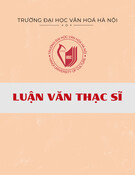
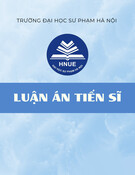
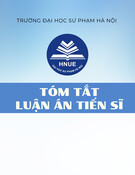
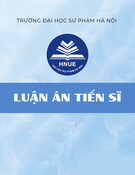


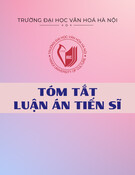
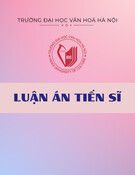
![Phát hiện và nhận dạng tiếng Việt trong ảnh CCCD, ảnh ngoại cảnh: Nghiên cứu phương pháp nâng cao độ chính xác [Luận án Tiến sĩ]](https://cdn.tailieu.vn/images/document/thumbnail/2025/20250807/vijiraiya/135x160/7691754555235.jpg)
